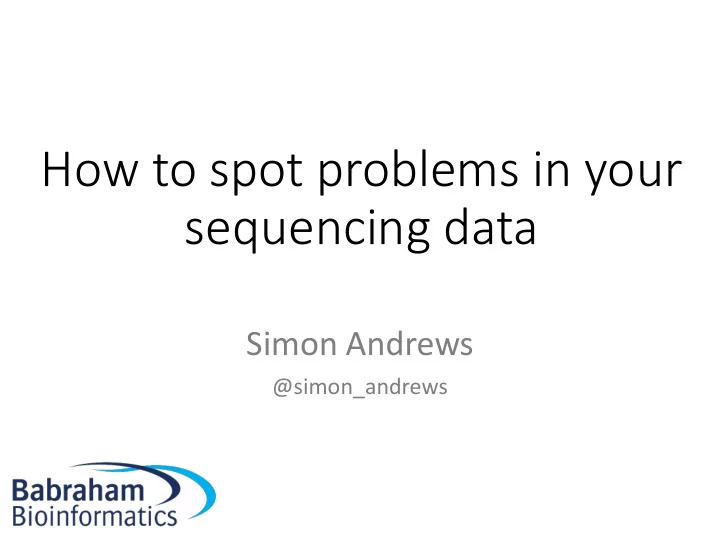

How to spot problems in your sequencing data Simon Andrews @simon_andrews
How to spot problems in your sequencing data experiment Simon Andrews @simon_andrews
Anne Segonds-Pichon Felix Krueger Simon Andrews Biostatistician Bioinformatician Head of Bioinformatics Steven Wingett Jo Montgomery Laura Biggins Bioinformatician Training Developer Bioinformatician
A Crisis of Analysis?
Experiments are fragile Grow Cells Extract RNA Create Library Sequence Functional Statistical Quantitate Align Analysis Tests Expression
QC at Babraham Bioinformatics • Software SeqMonk Bismark Giraph • Training In 2018 74 training days 1000 people trained
7 short stories…
Look at the metrics your instruments / programs give you
filtered lane tile read control run x,y instrument flowcell @HWUSI-EAS611:34:6669YAAXX:1:1:5069:1159 1:N:0: TCGATAATACCGTTTTTTTCCGTTTGATGTTGATACCATT + base calls IIHIIHIIIIIIIIIIIIIIIIIIIIIIIHIIIIHIIIII quality scores
FastQC per base quality plot
FastQC per base quality plot
FastQC per tile quality plot
BamQC indel plot FastQC per tile quality plot
Time loading forward index: 00:01:10 Time loading reference: 00:00:05 Multiseed full-index search: 00:20:47 24548251 reads; of these: 24548251 (100.00%) were paired; of these: 1472534 (6.00%) aligned concordantly 0 times 21491188 (87.55%) aligned concordantly exactly 1 time 1584529 (6.45%) aligned concordantly >1 times 94.00% overall alignment rate Time searching: 00:20:52 Overall time: 00:22:02
Take note of flags, warnings and errors
the design formula contains a numeric variable with integer values, specifying a model with increasing fold change for higher values. did you mean for this to be a factor? if so, first convert this variable to a factor using the factor() function 1: In fitNbinomGLMs(objectNZ, maxit = maxit, useOptim = useOptim, useQR = useQR, : 1rows had non-positive estimates of variance for coefficients
Look at your data
Google: “Simple RNA -Seq analysis”
RNA-Seq BS-Seq
“Moreover , TDCIPP exposure predominantly resulted in hypomethylatio ion of positions outside of CpG islands and with thin intragenic (e (exon) reg egions of the zebrafish genome .”
Validate what you know about your samples
Gene Knockout WT KO
Sample sex
Check your quantitations
FPKM Dorottya Horkai
FPKM + Size Factors Dorottya Horkai
FPKM + Size Factors Dorottya Horkai
FPKM + Size Factors + Quantile Dorottya Horkai
Look for global explanations before local ones
A ‘local’ explanation makes sense
A ‘global’ explanation is most important
There is obvious structure in the hits
Work backwards through your hits
Gene ID Description P-Value FDR Log2 FC FUT11 ENSG00000196968 fucosyltransferase 11 3.07E-04 0.0010 0.6677 RHOF ENSG00000139725 ras homolog gene family, member F 3.08E-04 0.0010 0.5691 STAB1 ENSG00000010327 stabilin 1 3.09E-04 0.0010 2.2114 CTNNA1 ENSG00000044115 catenin 3.10E-04 0.0010 0.4730 RAB19 ENSG00000146955 member RAS oncogene family 3.10E-04 0.0010 -2.2223 PPWD1 ENSG00000113593 peptidylprolyl isomerase domain and WD repeat containing 1 3.11E-04 0.0011 0.5757 KCNC3 ENSG00000131398 potassium voltage-gated channel, member 3 3.15E-04 0.0011 -1.0448 CERKL ENSG00000188452 ceramide kinase-like 3.16E-04 0.0011 1.5089 FBXL8 ENSG00000135722 F-box and leucine-rich repeat protein 8 3.17E-04 0.0011 -1.1472 ZNF488 ENSG00000165388 zinc finger protein 488 3.17E-04 0.0011 -1.4103 FAM82A2 ENSG00000137824 family with sequence similarity 82, member A2 3.17E-04 0.0011 -0.5956 NIT1 ENSG00000158793 nitrilase 1 3.19E-04 0.0011 0.6283
Group 1 Group 2
Group 1 Group 2
Summary 1. Look at your metrics 2. Take notes of errors/warnings 3. Look at your data 4. Validate what you know 5. Check your quantitation 6. Look globally before locally 7. Work backwards through your hits
Anne Segonds-Pichon Felix Krueger Laura Biggins Christel Krueger Phil Ewels Steven Wingett www.bioinformatics.babraham.ac.uk 10Xqc.com qcfail.com
Sequencing.qcfail.com Statistics.qcfail.com Imaging.qcfail.com Proteomics.qcfail.com Genomics.qcfail.com Flowcytometry.qcfail.com
Recommend
More recommend